
Solanum is a large and diverse genus of flowering plants, which include three food crops of high economic importance, the potato, the tomato and the eggplant. It also contains the nightshades and horse nettles, as well as numerous plants cultivated for their ornamental flowers and fruit.

Solanum dulcamara, also known as bittersweet, bittersweet nightshade, bitter nightshade, blue bindweed, Amara Dulcis, climbing nightshade, fellenwort, felonwood, poisonberry, poisonflower, scarlet berry, snakeberry, trailing bittersweet, trailing nightshade, violet bloom, or woody nightshade, is a species of vine in the potato genus Solanum, family Solanaceae. It is native to Europe and Asia, and widely naturalised elsewhere, including North America, where it is an invasive problem weed.

Solanum ptychanthum, the West Indian nightshade or eastern black nightshade, is an annual or occasionally perennial plant in the Solanaceae (Nightshade) family. It is typically 15–60 cm tall and many branched.
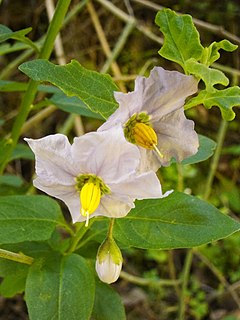
Solanum umbelliferum is a species of nightshade known commonly as bluewitch nightshade, or bluewitch. It can be found in chaparral habitat and low-elevation oak woodlands in California and parts of Baja California and Arizona. It is a small perennial herb or subshrub with dark gray-green oval-shaped leaves on hairy green stems that grow to a maximum height of one meter. It has bright purple or blue frilly flowers with thick yellow anthers at the center. The flowers close into spherical buds overnight. It bears small round green fruits which turn purple when ripe and resemble tiny eggplants.
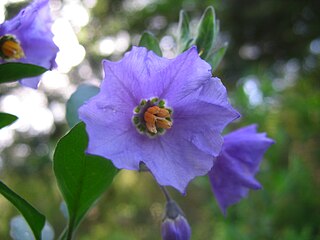
Solanum xanti, known commonly as chaparral nightshade, purple nightshade, and San Diego nightshade, is a member of the genus Solanum. It is native to the Western United States in Arizona, California, Nevada, and Oregon, and to northwest Mexico in Baja California.

Erigeron parishii is a species of flowering plant in the daisy family known by the common name Parish's fleabane.
Heuchera parishii is a species of flowering plant in the saxifrage family known by the common names Mill Creek alumroot and Parish's alumroot. It is endemic to California, where it is found in the San Bernardino Mountains. This is a rhizomatous perennial herb producing a patch of lobed, kidney-shaped leaves up to four centimeters wide. It bears an erect inflorescence up to about 27 centimeters in height which blooms in dense clusters of salmon-pink flowers. The plant gets its common name from Mill Creek.

Solanum citrullifolium is a species of nightshade commonly known as the watermelon nightshade, as its leaves somewhat resemble those of a watermelon plant. It is a white-stemmed shrub with purple star-shaped flowers. It is native to the southern United States and it is grown in home gardens as an ornamental plant.

Solanum physalifolium, known as hoe nightshade, Argentine nightshade, green nightshade and hairy nightshade, is a species in the family Solanaceae. Native to Argentina, Bolivia and Chile, it is widely naturalized in Australia, New Zealand, Europe, western Canada and the north western United States. Solanum physalifolium has been widely but incorrectly known as Solanum sarrachoides, a different species. It has been listed as a noxious weed in the US states of Kansas and Michigan under this misapplied name.

Grusonia parishii is a species of cactus known by the common names matted cholla and Parish club cholla. It is native to the Mojave and Sonoran Deserts of California and Arizona.

Oxytheca parishii is a species of flowering plant in the buckwheat family known by the common name Parish's oxytheca. It is endemic to California, where it is known only from the Transverse Ranges and nearby slopes of the southernmost Central Coast Ranges. It grows in dry and rocky mountain soils. It is an annual herb producing a waxy, hairless, leafless stem up to about 60 centimeters in maximum height in the spring when it is time to flower; during the winter the plant is a small rosette of oval leaves a few centimeters wide. The inflorescence atop the stem is an array of small cymes of flowers, each enveloped in a partially fused cup of bracts tipped in spinelike awns. The flower has six hairy white or pinkish lobes.
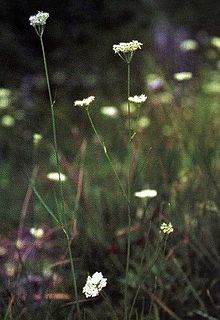
Perideridia parishii is a species of flowering plant in the family Apiaceae known by the common name Parish's yampah. It is native to mountainous regions of the southwestern United States, where it grows in forests and other habitat. It is a perennial herb growing up to 90 centimeters tall, its slender green stem growing from a small tuber. Leaves near the base of the plant have blades 10 to 20 centimeters long divided into pairs of leaflets, which may be subdivided or lobed. The inflorescence is a compound umbel of many spherical clusters of small white flowers. These yield ribbed, round or oblong-shaped fruits each about half a centimeter long.
Plagiobothrys parishii, known by the common name Parish's popcornflower, is an uncommon species of flowering plant in the borage family.
Solanum dimidiatum is a species of plant in the family Solanaceae known by the common names western horsenettle, Torrey's nightshade, and robust horsenettle. It is native to the central United States, where it grows in many types of habitat, including disturbed areas. In California it is known as an introduced species and a noxious weed. It is a rhizomatous perennial herb producing an erect stem up to 80 centimeters tall. It is covered in yellow prickles and branched hairs. The leaves may be up to 15 centimeters long, their edges wavy to lobed and sometimes toothed. The inflorescence is a branching array of several flowers. Each flower has a bell-shaped corolla measuring 3 to 5 centimeters wide. It is lavender to purple, or white. The five large, yellow anthers are about a centimeter long. The fruit is a spherical yellow berry up to 3 centimeters wide.
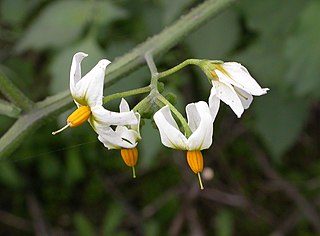
Solanum douglasii is a species of plant in the family Solanaceae known by the common name greenspot nightshade.
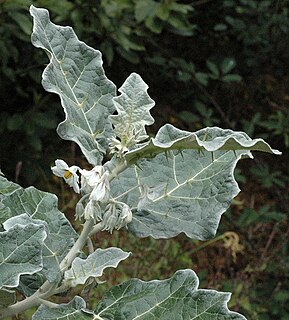
Solanum marginatum is a species of plant in the family Solanaceae known by the common names purple African nightshade and white-margined nightshade. It is native to Ethiopia and Eritrea, and it is known on other continents as an introduced species and sometimes a weed. It is a hairy shrub growing up to two meters tall. The large, distinctive, gray-green leaves are wavy along the edges, woolly on the undersides, and measure up to 18 centimeters long. The veins are white and lined with large, widely spaced prickles. The inflorescence contains several white flowers, hanging or nodding bisexual flowers and erect staminate flowers with large yellow anthers. The fruit is a yellow berry up to 5 centimeters wide.

Solanum triflorum is a species of nightshade known by the common names cutleaf nightshade and small nightshade. It is native to Argentina, but it is known on other continents, including Europe and Australia, as an introduced species and sometimes a weed. It is present throughout much of North America, where it is possibly non-native as well. It grows in many types of habitat, including disturbed areas. It is an annual herb producing spreading, decumbent stems up one meter long. It is hairy, the hairs sometimes associated with glands. The leaves are a few centimeters long and are deeply cut into toothlike lobes. The inflorescence bears two or three flowers each just under a centimeter wide when fully open. The flower is usually white, but is occasionally purple-tinged. The fruit is a berry roughly a centimeter wide.

Solanum diphyllum, commonly known as the twoleaf nightshade, is a species of nightshade native to the Americas. It is cultivated as an ornamental plant for its clusters of dark green round fruits that turn a bright yellow when ripe.

Solanum sandwicense is a rare species of flowering plant in the nightshade family known by the common names Hawai'i horsenettle and popolo 'aiakeakua. It is endemic to Hawaii, where it occurs today on the islands of Kauai and Oahu. It is threatened by the destruction and degradation of its habitat. It is a federally listed endangered species of the United States.

Solanum villosum, the hairy nightshade, red nightshade or woolly nightshade, is a sprawling annual weed in Europe, western Asia, northern Africa, North America, and is also naturalized in Australia.

















